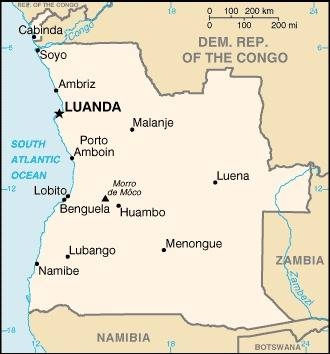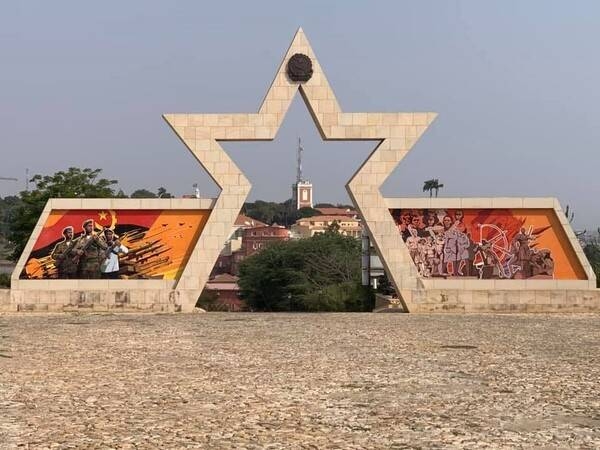178 Angola

Two equal horizontal bands of red (top) and black with a centered yellow emblem consisting of a five-pointed star within half a cogwheel crossed by a machete (in the style of a hammer and sickle). Red represents liberty and black the African continent. The symbols characterize workers and peasants.
Flag courtesy of the CIA World Factbook

Map courtesy of the CIA World Factbook

Fortaleza de Sao Miguel (Saint Michael Fortress) is a Portuguese polygonal-form fortress built in 1575 on a high plateau overlooking Luanda and the bay. The fortress was the administrative center of the colony and a major outlet for the slave trade. Today Fortaleza de Sao Miguel is a major tourist attraction and houses a museum of Angola’s armed forces.
Photo courtesy of the CIA World Factbook
Government
According to Britannica, Portugal granted independence to Angola on November 11, 1975, without establishing a new government. The Popular Movement for the Liberation of Angola (Movimento Popular de Libertação de Angola; MPLA), led by Agostinho Neto and based in Luanda, took power, an act that was internationally, though not universally, recognized. The constitution of 1975 established a one-party state headed by a president who was also chairman of the MPLA, which declared itself a Marxist-Leninist vanguard party in 1977. The positions of prime minister and deputy prime minister were abolished in 1978, with a prime minister not appointed again until 1991; a National People’s Assembly was created in 1980. President Neto died in Moscow in 1979 and was replaced by the minister of planning, José Eduardo dos Santos. Early in 1990 the government proposed separating the offices of chairman of the party and president of state, a division already mandated by the constitution.
A new constitution, essentially an extensively amended version of the 1975 document, was promulgated in 1992. Prepared with the acquiescence of the National Union for the Total Independence of Angola (União Nacional para a Independência Total de Angola; UNITA), it provided for a multiparty system with a directly elected president as the head of state and government, assisted by a prime minister. The constitution abolished the death penalty and emphasized the rights of the people.
The country’s current constitution, promulgated in 2010, eliminated the post of prime minister, added the post of vice president, and strengthened the role of the president. It eliminated the direct election of the president and instead provided for the presidential post to be filled by the leader of the party with the largest share of the vote in legislative elections. The president is limited to two five-year terms. Legislative power is vested in the National Assembly, whose members are elected to four-year terms.
Angola is divided into 18 provinces, each of which is headed by a governor appointed by the central government. Provinces are further divided into councils, communes, circles, neighbourhoods, and villages.
The judiciary consists of municipal and provincial courts, with the highest body being the Supreme Court. Operations of lower courts were disrupted by the civil war, and, in the years immediately following the end of the war, the majority of municipal courts were still not functioning.
National Civil Aviation Authority (NCAA)
National Civil Aviation Authority (NCAA) was created by Law no. 14/19, of 23 May, Civil Aviation Law and implemented by Law no. 28/21, of 25 October. NCAA is a legal person governed by public law with the nature of an independent administrative regulatory entity, with legal personality, judicial, functional, technical, financial, patrimonial and regulatory capacity for all activities related to the civil aviation sector carried out in Angolan territory. The NCAA is the entity that, in terms of civil aviation, exercises the functions of regulation, supervision, guidance, control, regulation, supervision, inspection, certification, approval, licensing, authorization, audit and application of sanctions in the aviation sector.
Airspace
SkyVector – Google Maps – ADS-B Exchange
ICAO countries publish an Aeronautical Information Publication (AIP). This document is divided into three parts: General (GEN), En Route (ENR) and Aerodromes (AD). ENR 1.4 details the types of airspace classes they chose to adopt from classes A through G.
Drone Regulations
Advanced Air Mobility (AAM) Regulations & Policies
None found by the author.
However, should you, the reader, happen to stumble across something to the contrary, please email the author at FISHE5CA@erau.edu and you may be mentioned in the ACKNOWLEDGEMENTS section of this book by way of thanks for contributing to this free eBook!
Advanced Air Mobility (AAM) News
None found by the author.
However, should you, the reader, happen to stumble across something to the contrary, please email the author at FISHE5CA@erau.edu and you may be mentioned in the ACKNOWLEDGEMENTS section of this book by way of thanks for contributing to this free eBook!
Short Essay Questions
Scenario-Based Question
You have been hired by a Drone Startup Company. Your boss has immediately assigned this job to you.
They need you to prepare a one-page memo detailing the legalities of using a drone to film the Fortress, pictured above.
They need you to mention any national laws and local ordinances.
They specifically want to know what airspace (insert pictures) you will be operating in and whether or not you need an airspace authorization.
Does it matter whether or not you are a citizen of the country?
Lastly, there is a bonus for you if, as you scroll through this chapter, you find any typos or broken links!
Short Essay Questions
- What are the drone categories?
- How is registration addressed?
- How is remote ID addressed?
- What are the model aircraft rules?
- What are the commercial drone rules?
- Are there waivers or exemptions to the rules? If so, for what?
- Would you share a link to an interactive airspace map?
- How is BVLOS addressed?
- How can you fly drones at night?
- How can you fly drones over people?
- Where do you find drone NOTAMs?
- What are the rules for drone maintenance?
- What are the rules for an SMS program?
- What are some unique rules not mentioned above?
- What are the C-UAS rules?
- What are the AAM rules?

